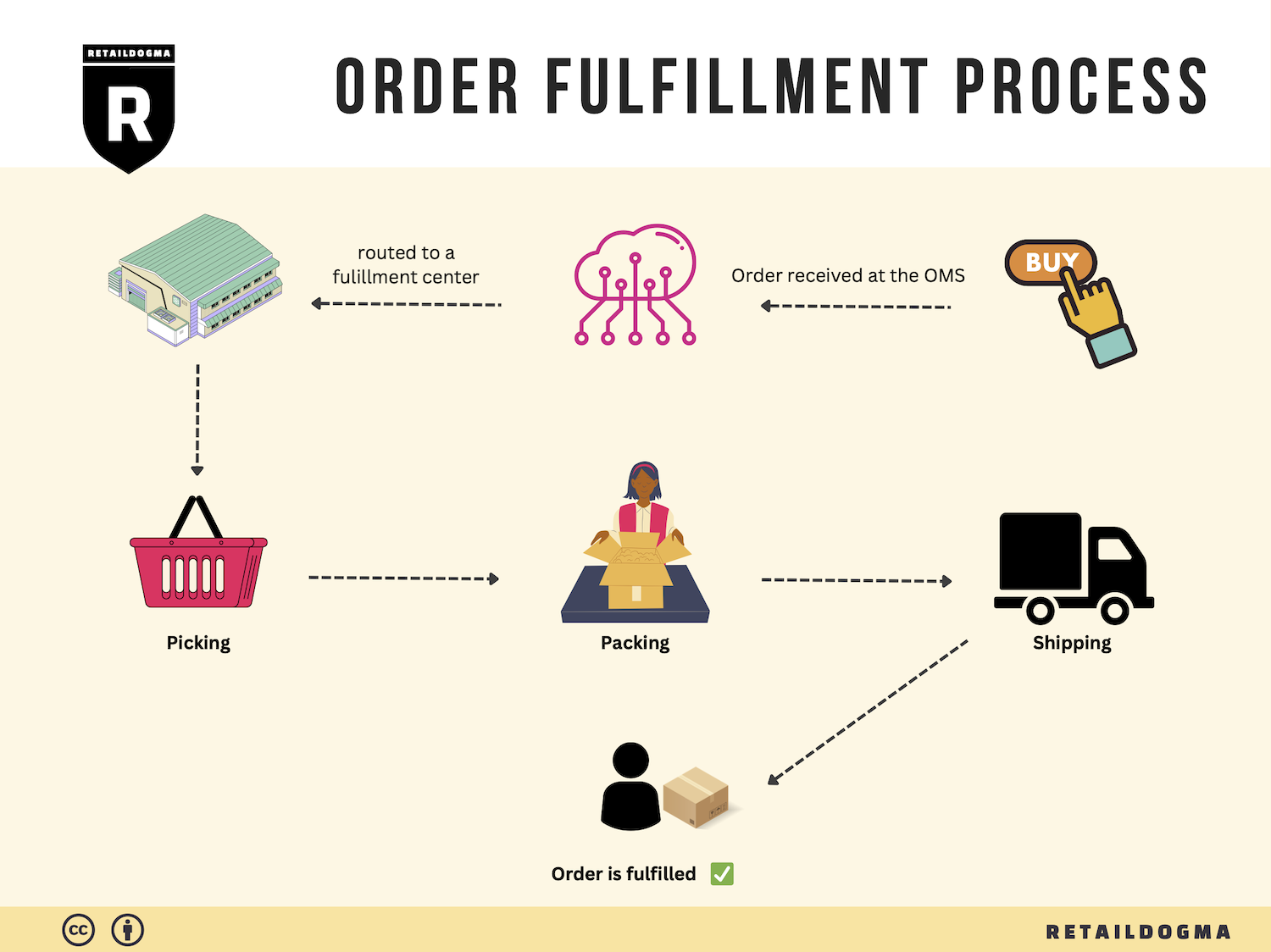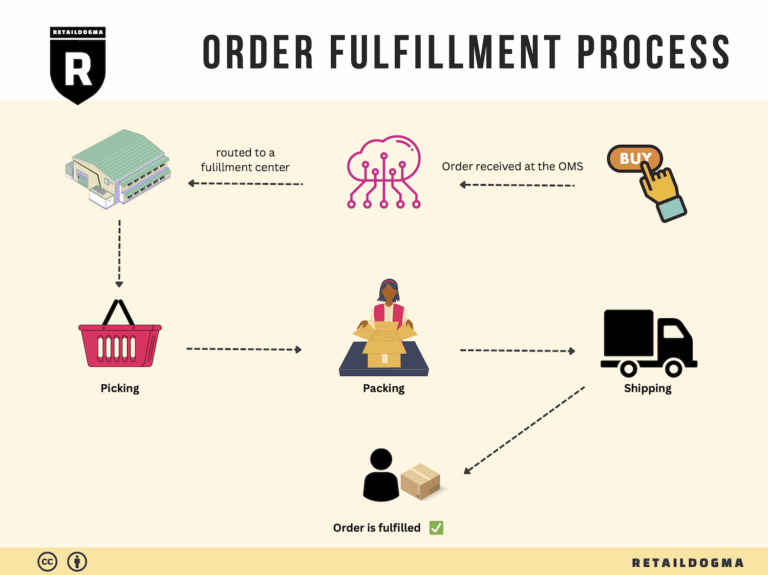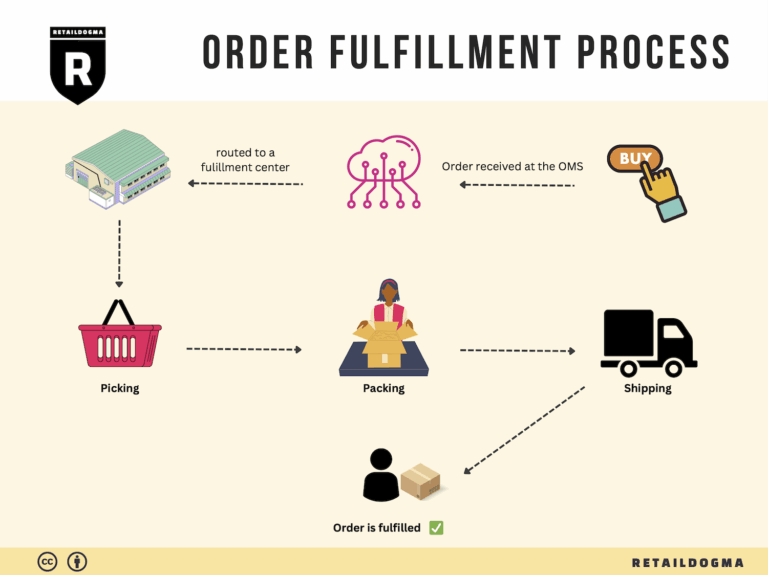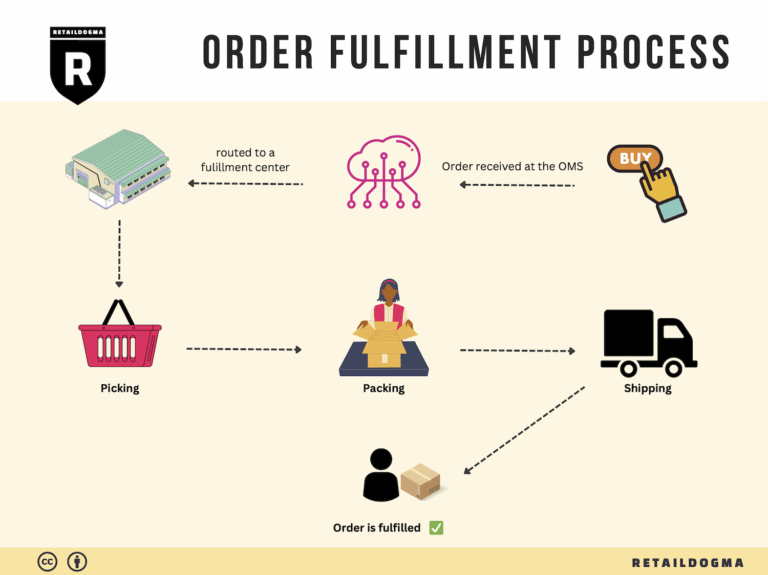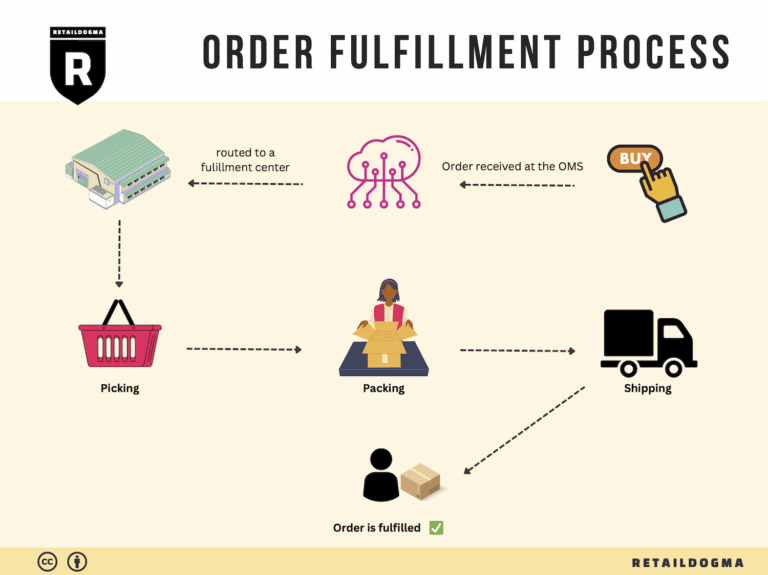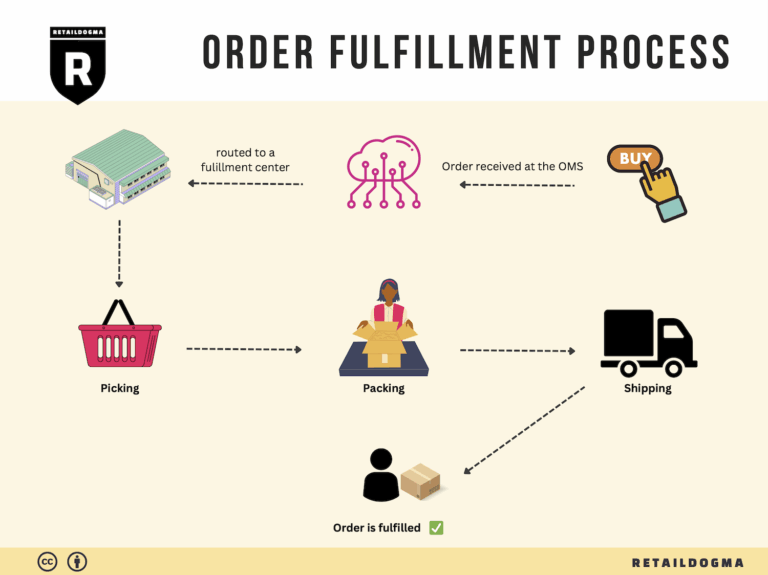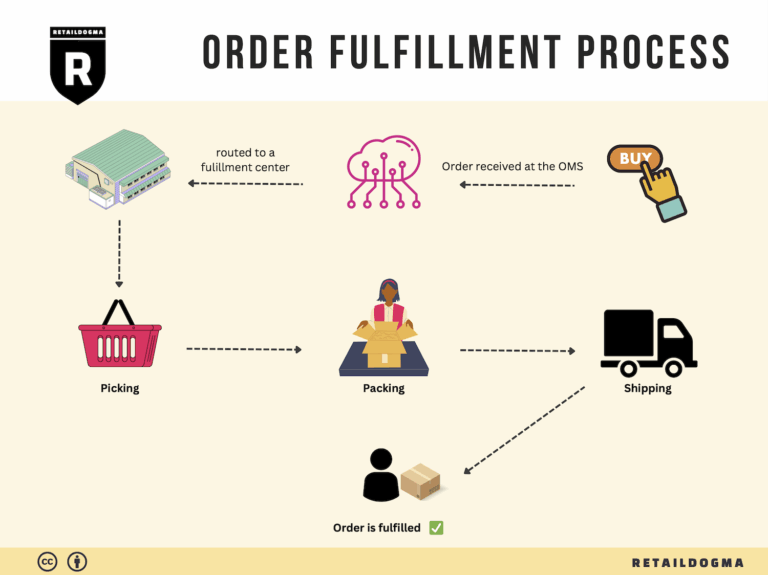Ecommerce Fulfillment Services: The Ultimate Guide (2025)
What is E-commerce Fulfillment? An Introduction for Growing Businesses
Understanding E-commerce Fulfillment
As an e-commerce business owner, you may find yourself overwhelmed with the logistical challenges of packing and shipping orders. The excitement of growing your online store can quickly turn into stress when faced with the complexities of order fulfillment. From managing inventory to ensuring timely deliveries, the process of getting a product to a customer can become a significant pain point, especially as your sales scale.
E-commerce fulfillment is essentially the backbone of your online business. It encompasses the entire process of receiving, processing, and delivering products to customers. This includes everything from warehousing inventory and picking items from shelves to packaging orders and shipping them to their final destinations. For growing businesses, understanding and optimizing this process is crucial for maintaining customer satisfaction and driving repeat purchases.
This guide aims to demystify the various aspects of e-commerce fulfillment, providing you with the knowledge needed to navigate this critical area of your business effectively. We will explore different fulfillment models, such as Third-Party Logistics (3PL) and Fulfillment by Amazon (FBA), highlighting the advantages and drawbacks of each. This understanding will help you determine which model aligns best with your business goals and customer expectations.
Additionally, we will delve into the core services involved in fulfillment, such as inventory management, order processing, and returns handling. These services are essential for streamlining operations and ensuring that your customers receive their products in a timely manner.
Choosing the right fulfillment partner is another key topic we will cover. With numerous options available, it’s vital to assess potential partners based on their capabilities, technology, scalability, and pricing. We will provide practical tips for evaluating partners to ensure they meet your unique business needs.
Finally, we will discuss pricing structures associated with different fulfillment services, helping you understand how to budget effectively and avoid unexpected costs.
Our goal with this guide is to empower you to make informed decisions about your logistics strategy. By understanding the fundamentals of e-commerce fulfillment, you can enhance your operational efficiency, improve customer satisfaction, and ultimately scale your business with confidence.
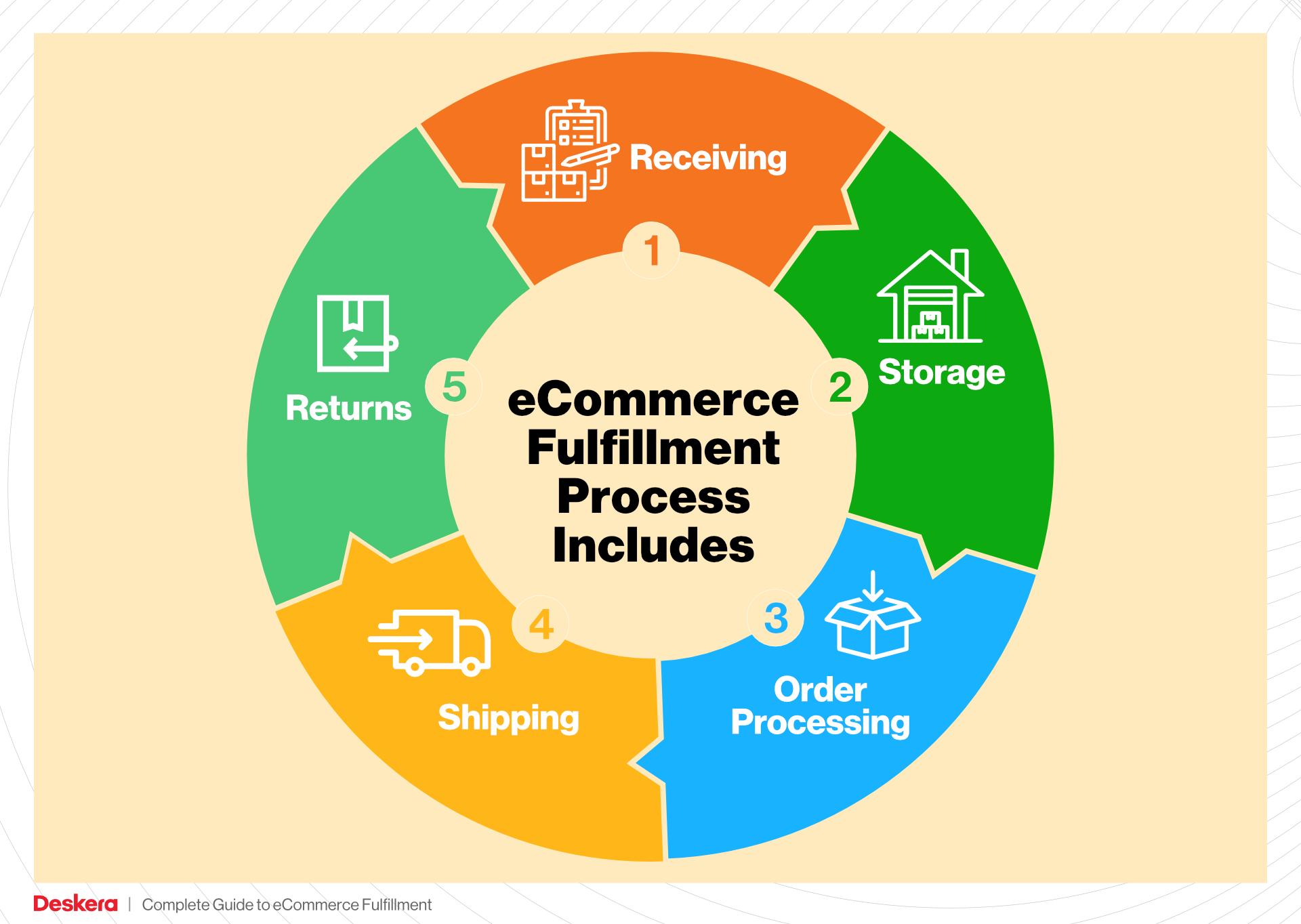
What You’ll Learn In This Guide
- What is E-commerce Fulfillment? An Introduction for Growing Businesses
- The Order Fulfillment Process: From ‘Buy’ Button to Customer’s Door
- Comparing Fulfillment Models: In-House vs. 3PL vs. Dropshipping
- A Deep Dive into Amazon FBA: Pros, Cons, and Who It’s For
- Core Services Offered by Fulfillment Centers
- How to Choose a Fulfillment Partner: A 6-Point Checklist
- Understanding Fulfillment Pricing: A Breakdown of Common Fees
- Frequently Asked Questions (FAQs) about Fulfillment
- Conclusion: Is Outsourcing Fulfillment the Right Move for Your Business?
- Important Disclaimer
The Order Fulfillment Process: From ‘Buy’ Button to Customer’s Door
1. Receiving Inventory
The order fulfillment process begins with receiving inventory at the fulfillment center. This step is crucial as it establishes the foundation for efficient operations. When products arrive at the Amazon Fulfillment Center in Baltimore, they undergo a thorough inspection to ensure they meet quality standards and match the purchase orders. Each item is assigned a Stock Keeping Unit (SKU), a unique identifier that helps track inventory levels and sales.
This step is important because accurate receiving is essential for maintaining inventory accuracy, preventing stockouts, and ensuring that customers receive their orders on time. If discrepancies occur during this phase, they can lead to delays and customer dissatisfaction. Efficient inventory management systems must be employed to log and categorize received products swiftly, ensuring that they are ready for the next steps in the fulfillment process.
2. Warehouse Storage
Once inventory is received and verified, it is stored in the warehouse. Amazon’s fulfillment centers use sophisticated storage systems that optimize space and facilitate easy access to products. Items are typically organized based on their SKU, size, and demand frequency, allowing for efficient retrieval.
The significance of effective warehouse storage cannot be overstated. Proper organization minimizes the time it takes to locate and pick items for orders, which in turn reduces overall fulfillment time. Additionally, strategic storage can help manage costs related to storage fees, especially when using Fulfillment by Amazon (FBA), where fees are associated with the volume of goods stored. Implementing a robust Warehouse Management System (WMS) can streamline this process by providing real-time data on inventory levels and locations.
3. Order Picking
The next step in the fulfillment process is order picking, where items are selected from storage to fulfill customer orders. Amazon utilizes a pick list, a document that outlines the specific items and quantities needed for each order. This list guides warehouse associates in efficiently locating and retrieving products.
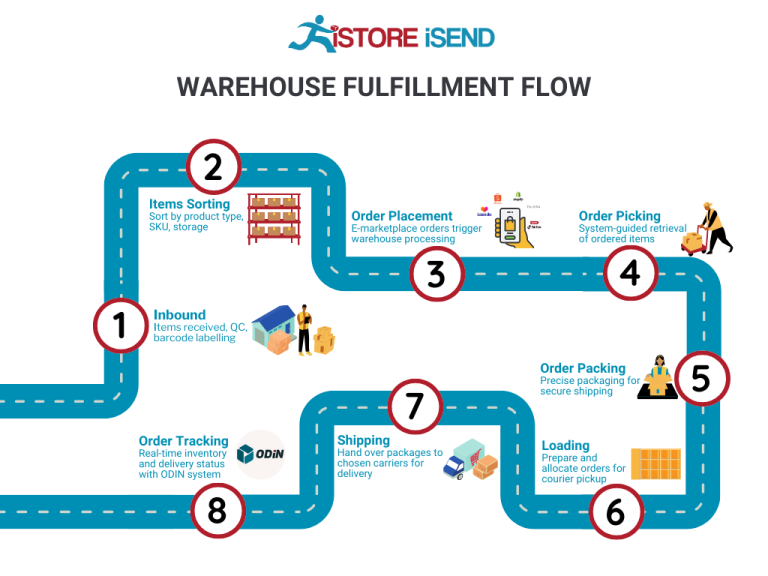
Order picking is a critical phase because it directly impacts the speed and accuracy of order fulfillment. Errors during picking can lead to incorrect shipments, resulting in returns and customer dissatisfaction. To enhance picking efficiency, many fulfillment centers use methods such as batch picking, where multiple orders are picked simultaneously, or zone picking, where each picker is responsible for a specific area of the warehouse. Investing in technology such as barcode scanners can further reduce errors and improve speed in this step.
4. Order Packing
After items are picked, they move to the packing stage. This involves carefully packing products into boxes or envelopes, ensuring they are protected during transit. Proper packing is essential for preventing damage, which can lead to returns and additional costs. Amazon employs packing slips, which accompany each order to provide customers with an itemized list of what they received.
Effective packing is vital not only for customer satisfaction but also for optimizing shipping costs. Using the right-sized packaging can reduce dimensional weight charges, leading to cost savings. Additionally, branded packaging can enhance the customer experience, although FBA limits branding options. Implementing packing automation tools can help increase efficiency and accuracy, allowing for faster order processing.
5. Shipping & Delivery
The final step in the order fulfillment process is shipping and delivery. Once packages are packed, they are labeled and prepared for shipment. Amazon’s fulfillment centers leverage advanced logistics networks to ensure timely delivery, often utilizing local distribution centers to facilitate rapid shipping.
This step is crucial as it directly affects customer satisfaction and retention. Fast and reliable shipping options, such as Amazon Prime’s two-day delivery, can significantly enhance the customer experience and drive repeat purchases. Understanding the key performance indicators (KPIs) associated with shipping, such as on-time delivery rates and shipping costs, can help businesses optimize their logistics strategies. Moreover, utilizing tracking systems allows customers to monitor their orders in real-time, increasing transparency and trust in the brand.
In conclusion, mastering the order fulfillment process is essential for e-commerce success. By focusing on each of these five steps—receiving inventory, warehouse storage, order picking, order packing, and shipping & delivery—businesses can streamline operations, improve customer satisfaction, and ultimately scale their e-commerce ventures effectively.
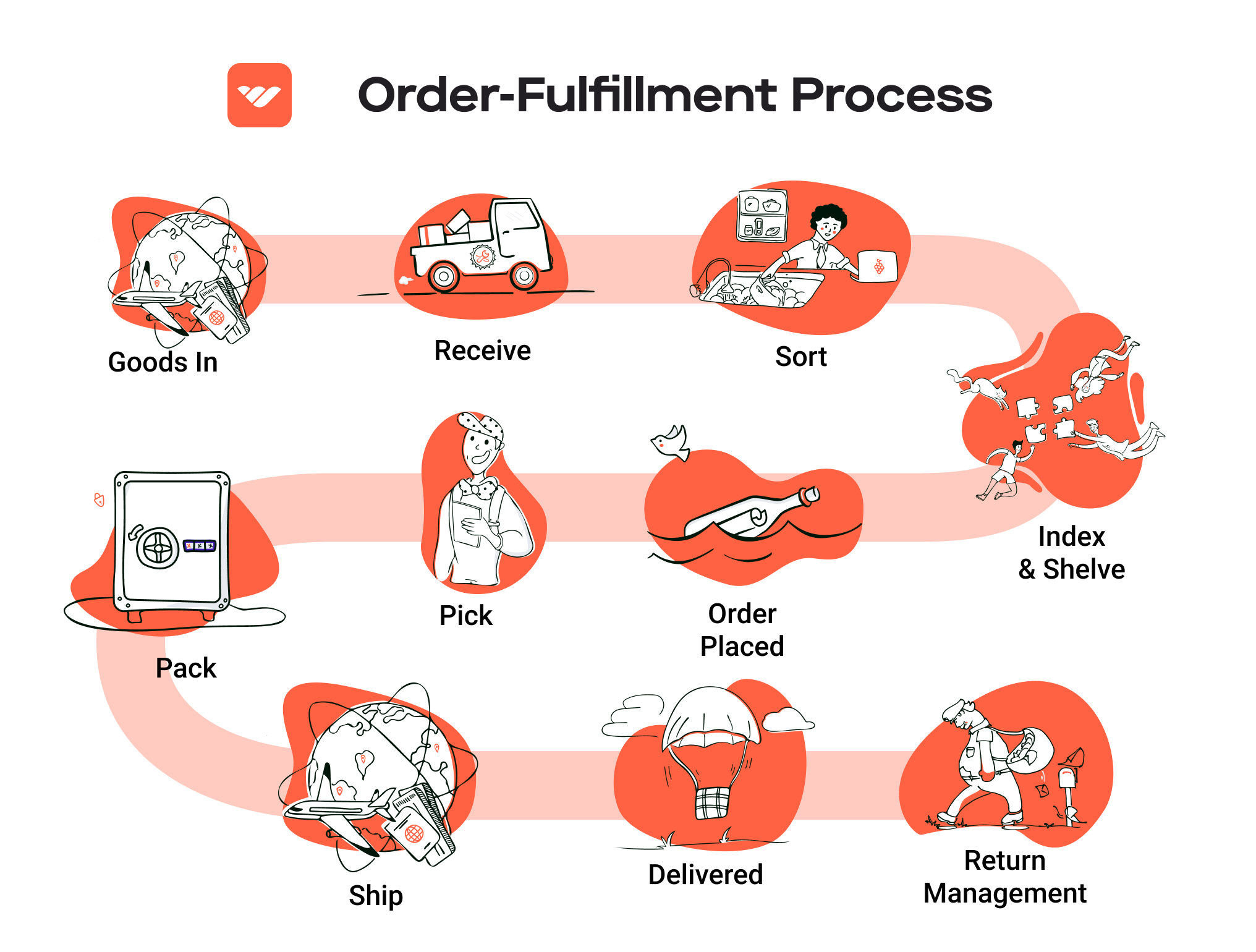
Comparing Fulfillment Models: In-House vs. 3PL vs. Dropshipping
Comparison of Fulfillment Models
| Model | Who Handles Inventory | Best For (Business Stage) | Key Advantage | Key Disadvantage |
|---|---|---|---|---|
| In-House Fulfillment | The business itself | Startups to established brands | Full control over inventory and branding | High overhead costs and operational complexity |
| Third-Party Logistics (3PL) | Third-party providers | Growing businesses | Scalability and expertise in logistics | Less control over inventory and processes |
| Dropshipping | Supplier | New entrants and niche brands | Low startup costs and no inventory risk | Lower profit margins and potential for stock issues |
In-House Fulfillment
In-house fulfillment involves managing your own warehousing and logistics operations. This model is often favored by startups and established brands that want full control over their inventory, branding, and customer experience. Businesses that choose in-house fulfillment have the advantage of customizing their packaging and branding, which can enhance customer loyalty. They also retain complete oversight of inventory levels, fulfillment processes, and quality control. However, the disadvantages are significant: high operational costs associated with staffing, warehousing, and technology investments can hinder growth. Additionally, managing logistics can be complex, requiring dedicated resources and expertise. As sales scale, the burden of handling increased order volumes can lead to inefficiencies and operational challenges.
Third-Party Logistics (3PL)
Third-party logistics (3PL) is a popular choice for growing businesses that seek to scale without the burden of managing logistics internally. In this model, a third-party provider manages storage, inventory, and shipping on behalf of the business. This allows e-commerce companies to leverage the expertise of logistics professionals, which can lead to faster shipping times and improved customer satisfaction. 3PL providers often have established networks and technology to streamline operations, enabling businesses to focus on sales and marketing rather than logistics. The key disadvantage is that businesses relinquish some control over their inventory and fulfillment processes, which can affect branding and customer experience. Additionally, costs can accumulate with storage fees, order handling, and shipping, making it essential for businesses to analyze their margins closely.
Dropshipping
Dropshipping is an increasingly popular fulfillment model, especially for new entrants and niche brands. In this model, the seller lists products on their website but does not hold any inventory. Instead, when an order is placed, the seller purchases the item from a third-party supplier, who then ships it directly to the customer. The primary advantage of dropshipping is the low startup cost; businesses do not need to invest in inventory or warehouse space. This model reduces financial risk significantly, as businesses only pay for products after a sale is made. However, dropshipping comes with its own set of challenges. Profit margins are often lower due to reliance on suppliers, and businesses have little control over inventory levels and shipping times. This can lead to stock issues or delays, potentially damaging customer satisfaction and brand reputation.
Conclusion
Choosing the right fulfillment model is crucial for scaling your e-commerce business. Each model offers unique advantages and disadvantages that must align with your business goals, operational capacity, and market demands. In-house fulfillment provides control but at a high cost, while 3PL offers scalability and expertise but can lead to less control. Dropshipping minimizes financial risk but often results in lower profit margins and less brand control. Understanding these dynamics will enable you to make informed decisions that support your growth strategy and enhance customer satisfaction.
A Deep Dive into Amazon FBA: Pros, Cons, and Who It’s For
Understanding Fulfillment by Amazon (FBA)
Fulfillment by Amazon (FBA) is a service provided by Amazon that allows sellers to store their products in Amazon’s fulfillment centers. Amazon then takes care of storage, packaging, shipping, and customer service on behalf of the sellers. This service is particularly appealing for e-commerce businesses looking to streamline their logistics and scale their operations without needing to manage the complexities of fulfillment themselves.
When a customer orders a product, Amazon picks, packs, and ships the item directly to the customer. This process not only simplifies the logistics for sellers but also gives their products the advantage of Amazon’s extensive distribution network and customer service infrastructure.
How FBA Works
-
Inventory Management: Sellers send their products to one or more of Amazon’s fulfillment centers. The number of centers utilized can depend on various factors, including the seller’s location and the expected demand for their products.
-
Storage Fees: Sellers pay storage fees based on the amount of space their products occupy in Amazon’s warehouses. These fees can vary based on the time of year; for example, they typically increase during the holiday season.
-
Order Fulfillment: When a customer places an order, Amazon handles the entire fulfillment process, including picking the product, packing it, and shipping it to the customer. This process is designed to be efficient, often resulting in quick delivery times.
-
Customer Service: Amazon also manages customer service and returns for FBA items, allowing sellers to focus on other aspects of their business.
-
Prime Eligibility: Products fulfilled by Amazon are eligible for Amazon Prime, which can significantly increase sales due to the appeal of fast, free shipping.
Pros of Using Amazon FBA
-
Prime Eligibility: One of the most significant advantages of using FBA is the ability to offer Amazon Prime shipping. This not only attracts more customers but can also lead to increased sales, as many shoppers filter their searches to show only Prime-eligible products.
-
Trust and Credibility: Products fulfilled by Amazon carry the trust associated with the Amazon brand. Customers are often more willing to purchase from sellers using FBA due to the reliability and customer service reputation of Amazon.
-
Multi-Channel Fulfillment: FBA is not limited to Amazon sales. Sellers can use Amazon’s fulfillment services to fulfill orders from their own websites or other marketplaces, which can simplify logistics and inventory management.
-
Scalability: FBA allows businesses to scale quickly without the need for extensive logistics infrastructure. As demand increases, sellers can simply send more products to Amazon’s warehouses.
-
Reduced Logistics Burden: With Amazon handling storage, packaging, shipping, and customer service, sellers can focus on product development and marketing instead of logistics.
Cons of Using Amazon FBA
-
High Fees: One of the most significant drawbacks of FBA is the associated costs. Sellers must pay for storage, fulfillment, and additional fees for returns, which can eat into profit margins, especially for low-cost items.
-
Strict Inventory Rules: Amazon has stringent rules regarding inventory management, including restrictions on certain types of products and requirements for labeling and packaging. Sellers must adhere to these guidelines to avoid penalties or removal of their listings.
-
Commingling Risks: FBA products may be commingled with products from other sellers. This means that if a customer receives a defective item, it can be difficult for sellers to determine if it originated from their inventory, potentially leading to negative reviews and returns.
-
Limited Branding: Sellers have limited control over packaging and branding when using FBA. Amazon’s standardized packaging can dilute a seller’s brand identity, making it harder to create a unique customer experience.
-
Inventory Management Complexity: Managing inventory across multiple fulfillment centers can be challenging. Sellers need to monitor stock levels closely to avoid stockouts or overstock situations, which can lead to additional fees or lost sales.
Who is FBA Best For?
FBA is particularly well-suited for:
-
Small to Medium-Sized Businesses: Sellers looking to scale quickly without investing heavily in logistics infrastructure can benefit significantly from FBA.
-
E-commerce Brands with High Sales Volumes: Businesses that anticipate high sales volumes can leverage FBA to manage logistics efficiently and take advantage of Prime eligibility.
-
Sellers Focused on Growth: If your goal is to expand your reach and sales, FBA can provide the logistics backbone needed to support that growth.
-
Brands that Prioritize Customer Trust: If your business strategy emphasizes building trust and credibility with customers, leveraging Amazon’s reputation through FBA can be a key advantage.
-
Sellers of Non-Seasonal, High-Demand Products: Products that consistently sell well and have high turnover can benefit from the efficiencies of FBA, making it easier to maintain stock levels and fulfill orders promptly.
In conclusion, while FBA offers numerous advantages that can help e-commerce businesses streamline their operations and increase sales, it is essential to weigh these benefits against the associated costs and potential downsides. Understanding your business’s unique needs and goals will help determine whether FBA is the right fulfillment solution for you.
Core Services Offered by Fulfillment Centers
Inventory Management & Warehousing
Inventory management and warehousing are foundational services provided by fulfillment centers, particularly essential for e-commerce businesses looking to streamline their operations. This service encompasses the systematic tracking and storage of products within a fulfillment center. The process typically involves receiving goods, organizing them in a manner that facilitates easy access, and maintaining accurate inventory records.
Benefits:
1. Real-Time Inventory Tracking: Fulfillment centers often utilize advanced inventory management systems that provide real-time visibility into stock levels. This allows e-commerce businesses to avoid overstocking or stockouts, which can lead to lost sales or increased holding costs.
-
Space Optimization: By leveraging the storage capabilities of fulfillment centers, businesses can free up valuable warehouse space on their premises, allowing for more efficient use of resources and reducing overhead costs.
-
Scalability: As businesses grow, fulfillment centers can quickly adjust their storage capacity to meet changing demands, enabling e-commerce companies to scale up operations without the logistical headaches of managing their own warehouse.
Pick and Pack Services
Pick and pack services are integral to the fulfillment process, focusing on the selection and packaging of products for shipment to customers. This service involves picking the correct items from the warehouse shelves, packing them securely, and preparing them for delivery.
Benefits:
1. Efficiency in Order Fulfillment: Fulfillment centers employ trained staff and advanced technology to streamline the picking and packing process. This efficiency reduces the time taken to fulfill orders, leading to faster shipping times and improved customer satisfaction.
-
Accuracy in Orders: With automated systems and experienced personnel, fulfillment centers minimize the risk of errors in order fulfillment. Accurate order processing not only enhances customer trust but also reduces costs associated with returns and exchanges.
-
Custom Packaging Options: Many fulfillment centers offer customization in packaging, which can help e-commerce businesses maintain their brand identity even during the shipping process. This can include branded boxes, inserts, and packing materials that enhance the customer experience.
Kitting and Assembly
Kitting and assembly services involve the grouping of multiple products into a single package or the assembly of products before shipment. This service is particularly beneficial for businesses that sell products that require assembly or are often sold as bundled items.
Benefits:
1. Enhanced Product Offering: By offering kitted products, e-commerce businesses can create unique packages that appeal to customers, potentially increasing average order values and enhancing the shopping experience.
-
Streamlined Logistics: Kitting reduces the need for multiple shipments, as several items can be bundled together. This can lead to lower shipping costs and simplified logistics, making it easier for businesses to manage their supply chains.
-
Time Savings: By outsourcing kitting and assembly to a fulfillment center, businesses can save significant time and labor costs. This allows internal teams to focus on core business activities such as marketing and customer service, rather than logistics.
Returns Management (Reverse Logistics)
Returns management, or reverse logistics, is the process of handling returned products efficiently and effectively. This service is crucial for e-commerce businesses, as online shopping often results in higher return rates compared to traditional retail.
Benefits:
1. Streamlined Return Processes: Fulfillment centers specialize in managing returns, making it easier for businesses to handle customer returns quickly. This efficiency can enhance customer satisfaction and loyalty, as customers appreciate hassle-free return experiences.
-
Inventory Replenishment: Efficient returns management allows businesses to quickly restock returned items back into inventory, minimizing the loss of potential sales. Fulfillment centers can assess the condition of returned products and determine the best course of action—whether to restock, refurbish, or recycle.
-
Data-Driven Insights: Fulfillment centers can provide valuable insights into return trends, helping businesses understand why products are being returned. This data can inform product development, marketing strategies, and inventory management, ultimately improving overall business performance.
In conclusion, partnering with a fulfillment center offers e-commerce businesses a range of core services designed to enhance operational efficiency, reduce costs, and improve customer satisfaction. By leveraging these services—inventory management and warehousing, pick and pack, kitting and assembly, and returns management—businesses can focus on scaling their operations while ensuring a seamless logistics experience for their customers.
How to Choose a Fulfillment Partner: A 6-Point Checklist
Location & Warehouse Network
Importance:
The geographic location of your fulfillment partner’s warehouses is crucial for optimizing shipping times and costs. A partner with a strategically positioned network can help ensure that your products reach customers quickly, which is especially important in the competitive e-commerce landscape.
Questions to Ask:
– Where are your warehouses located, and how do they align with my target market?
– What shipping methods do you offer, and what are the average delivery times?
– Do you have the ability to store products in multiple locations to facilitate quicker shipping?
Technology & Integrations
Importance:
In today’s fast-paced e-commerce environment, having advanced technology and seamless integrations with your sales channels is essential. A robust tech platform can streamline order processing, inventory management, and customer communications, reducing the risk of errors and enhancing customer satisfaction.
Questions to Ask:
– What software do you use for inventory management, and how frequently is it updated?
– Can your system integrate with my existing e-commerce platforms (e.g., Amazon, Shopify)?
– Do you provide real-time tracking and reporting features for order status and inventory levels?
Specializations (e.g., cold storage, oversized items)
Importance:
Different businesses have unique fulfillment needs, such as handling perishable goods or oversized items. Choosing a partner that specializes in your product type can lead to more efficient handling, better storage conditions, and compliance with regulatory standards.
Questions to Ask:
– Do you have specialized facilities for certain product types, such as refrigerated or oversized items?
– What safety and compliance measures do you have in place for handling sensitive products?
– Can you accommodate seasonal fluctuations in inventory or specific packaging requirements?
Scalability & Capacity
Importance:
As your business grows, your fulfillment partner must be able to scale operations accordingly. A partner that can handle increased order volumes without compromising service quality will help you maintain customer satisfaction and capitalize on growth opportunities.
Questions to Ask:
– What is your current capacity, and how do you manage peak seasons or sudden spikes in demand?
– Do you have a plan in place to expand your operations if my business requires it?
– How do you handle inventory overflow during high-demand periods?
Pricing and Contracts
Importance:
Understanding the pricing structure and contractual obligations is essential for budgeting and long-term planning. Transparent pricing helps avoid unexpected costs that could impact your profit margins.
Questions to Ask:
– Can you provide a detailed breakdown of your pricing structure (e.g., storage fees, pick-and-pack fees, shipping costs)?
– Are there any hidden fees I should be aware of, such as for returns or inventory storage?
– What are the terms of the contract, and what is the process for terminating or renegotiating it if needed?
Customer Support & Reviews
Importance:
Exceptional customer support is critical in logistics, where issues can arise unexpectedly. A responsive partner can resolve problems quickly, minimizing disruptions to your operations. Additionally, reviews from other businesses can provide insights into the partner’s reliability and service quality.
Questions to Ask:
– What customer support channels do you offer (e.g., phone, email, live chat), and what are your response times?
– Can you provide references from current or past clients, particularly those in my industry?
– How do you handle customer complaints or issues with order fulfillment?
Conclusion
Choosing the right fulfillment partner is a pivotal decision that can significantly impact your e-commerce business’s success. By carefully evaluating potential partners against these six criteria, you can ensure that you select a fulfillment provider that not only meets your current needs but also supports your future growth. Prioritize open communication and thorough due diligence to forge a partnership that enhances your operational efficiency and customer satisfaction.
Understanding Fulfillment Pricing: A Breakdown of Common Fees
Initial Setup Fees
Initial setup fees are typically incurred when you first establish your account with a fulfillment center. This fee can include the costs associated with account creation, onboarding, and integration with your e-commerce platform. Depending on the provider, this fee may vary significantly. Some fulfillment centers may offer a free setup, while others might charge a one-time fee that could range from $50 to several hundred dollars. It’s essential to inquire about what is included in this fee, as some providers may bundle additional services like software training or system integrations into their setup costs.
Receiving Fees
Receiving fees apply when your inventory arrives at the fulfillment center. This fee is generally calculated per pallet or per item received. For instance, if you send a large shipment, the receiving fee could be charged based on the total number of pallets processed. On average, receiving fees can range from $25 to $50 per pallet. Some providers may also charge for additional services during the receiving process, such as labeling or inspection. Understanding these costs upfront can help you budget effectively for inventory replenishment.
Storage Fees (per pallet/bin)
Storage fees are charged for the space your inventory occupies within the fulfillment center. These fees can be calculated on a monthly basis and are typically assessed per pallet or per bin. For example, storage fees may range from $10 to $30 per pallet per month, depending on the facility and the volume of your products. It’s important to note that many fulfillment centers also implement tiered pricing, where the storage cost may decrease as your volume increases. Additionally, be aware of potential long-term storage fees for items that remain in the warehouse for an extended period, often over six months. Regular inventory audits can help you avoid unnecessary storage costs.
Pick & Pack Fees (per item/order)
Pick and pack fees are incurred each time an order is fulfilled. This fee covers the cost of retrieving items from storage, packing them, and preparing them for shipment. Typically, pick and pack fees are charged on a per-item basis, ranging from $1 to $5 per item, or as a flat fee per order. For example, if an order contains three different items, the pick and pack fee might be calculated as $3 per item, resulting in a total of $9 for that order. Some fulfillment centers may also offer discounts for larger orders or high-volume shipments, so it’s beneficial to clarify these details to optimize your fulfillment costs.
Shipping Fees
Shipping fees are one of the most significant costs associated with fulfillment. These fees cover the cost of delivering the packages to customers and can vary widely based on factors such as package weight, dimensions, shipping speed, and destination. Most fulfillment centers work with major carriers and may offer discounted shipping rates due to their volume. Shipping fees may be charged per package, with rates ranging from a few dollars for lightweight items to significantly more for larger or expedited shipments. It’s crucial to compare shipping options and rates among different fulfillment centers to find the most cost-effective solutions for your business.
Tips for Getting an Accurate Quote
To secure an accurate quote from fulfillment centers, consider the following tips:
-
Provide Detailed Information: Clearly outline your product types, sizes, and shipping requirements. The more details you provide, the more accurate the quote will be.
-
Request Breakdown of Fees: Ask for a detailed breakdown of all potential fees, including setup, receiving, storage, pick and pack, and shipping fees. This transparency will help you understand the total cost of fulfillment.
-
Inquire About Volume Discounts: If you plan to scale your operations, ask about discounts for higher volumes. Some fulfillment centers offer better rates as your order quantities increase.
-
Evaluate Additional Services: Consider any extra services you may need, such as returns management, kitting, or custom packaging. These can affect your overall costs.
-
Negotiate Terms: Don’t hesitate to negotiate terms and pricing, especially if you are considering a long-term partnership. Many fulfillment centers are willing to work with you to create a mutually beneficial arrangement.
By understanding these common fees and following these tips, you can make informed decisions that will help scale your e-commerce business efficiently while managing costs effectively.
Frequently Asked Questions (FAQs) about Fulfillment
1. What is the Amazon Fulfillment Center in Baltimore?
The Amazon Fulfillment Center in Baltimore refers to two facilities located at 2010 Broening Hwy and 5501 Holabird Avenue. These centers play a crucial role in Amazon’s logistics network, enabling fast processing and shipping of products to customers in the Mid-Atlantic region and beyond.
2. What services does the Amazon Fulfillment Center in Baltimore offer?
The Amazon Fulfillment Centers provide a range of services, including storage, picking, packing, and shipping of products. They also handle customer service and returns for sellers using Amazon’s Fulfillment by Amazon (FBA) program, allowing businesses to focus on growth while Amazon manages logistics.
3. How does using Amazon FBA impact my sales?
Utilizing Amazon FBA gives your listings the Prime badge, significantly enhancing visibility and attracting more customers. With the promise of two-day shipping, it can lead to increased sales and customer satisfaction. However, sellers must be aware of associated fees and branding limitations.
4. What are the costs associated with using Amazon Fulfillment Centers?
Costs for using Amazon FBA include storage fees for inventory stored in their warehouses and fulfillment fees for each unit sold. These fees can vary based on the size and weight of the items. It’s essential to analyze your product margins to determine if FBA is the right choice for your business.
5. What’s the difference between a warehouse and a fulfillment center?
A warehouse is primarily a storage facility where goods are kept until needed. In contrast, a fulfillment center not only stores products but also processes orders, picks items, packs them, and ships them directly to customers. Fulfillment centers are designed to optimize the order fulfillment process.
6. What is a 3PL, and how does it relate to Amazon fulfillment?
A Third-Party Logistics (3PL) provider offers logistics services to businesses, including warehousing, transportation, and fulfillment. Combining 3PL services with Amazon FBA can be beneficial for businesses looking for more flexibility and potentially lower costs, especially if they want to maintain more control over branding and shipping.
7. How do I decide between using Amazon FBA and a 3PL?
The choice between FBA and a 3PL depends on your business needs. If you prioritize fast shipping and access to Amazon’s vast customer base, FBA may be ideal. However, if you seek more control over branding, customer interactions, and potentially lower fees, a 3PL might be the better option.
8. How can I get my products to the Amazon Fulfillment Center in Baltimore?
You can ship your products directly to the Amazon Fulfillment Center using a freight carrier or delivery service. Amazon provides specific guidelines on packaging and labeling, which must be followed to ensure your products are accepted and processed correctly.
9. What are the return policies for products fulfilled by Amazon?
Products fulfilled by Amazon can typically be returned within 30 days of delivery for a full refund, provided they are new and unopened. However, specific return policies may vary based on the seller’s preferences and the product type.
10. How can I ensure my products are stored correctly at the Amazon Fulfillment Center?
To ensure proper storage of your products at Amazon Fulfillment Centers, follow Amazon’s guidelines for inventory management, including accurate labeling, packaging, and shipping requirements. Regularly monitor your inventory levels and review performance metrics to optimize your storage strategy.
Conclusion: Is Outsourcing Fulfillment the Right Move for Your Business?
Assessing the Benefits of Outsourcing Fulfillment
Outsourcing your fulfillment process can be a game-changer for e-commerce businesses aiming to scale efficiently. By leveraging third-party fulfillment services, you can save valuable time that would otherwise be spent managing inventory, packing orders, and handling returns. This allows you to redirect your focus toward core business activities such as marketing, product development, and customer engagement, ultimately enhancing your overall operational efficiency.
Scalability is another significant advantage. As your business grows, the demand for your products may fluctuate. A reliable fulfillment partner can easily accommodate these changes, providing the necessary resources to handle increased order volumes during peak seasons without compromising service quality. This flexibility ensures that your business can adapt swiftly to market demands without the burden of investing in additional warehousing or staffing.
Moreover, partnering with an experienced fulfillment service brings specialized expertise to your operations. These providers are adept at navigating the complexities of logistics, shipping regulations, and inventory management, which can be particularly beneficial if you are expanding into new markets or regions. Their established networks can also facilitate faster delivery times, improving customer satisfaction and loyalty.
However, it’s crucial to choose the right fulfillment partner to align with your business goals. Consider factors such as location, service offerings, and technological capabilities, ensuring they can meet your specific needs while supporting your growth trajectory.
Call to Action
Take a moment to audit your current shipping process. Are you experiencing delays, excessive costs, or challenges in scaling? If so, it may be time to explore the benefits of outsourcing your fulfillment. Assess your options, reach out to potential partners, and discover how a strategic fulfillment solution can enhance your operational efficiency and drive growth for your business.
Important Disclaimer
⚠️ Important Disclaimer
The information in this guide is for educational purposes. Fulfillment services, pricing, and platform features change frequently. Always conduct your own due diligence and consult with providers directly before making business decisions.
